Comparison of Summer Coastal Currents off the East Coast of Korea in 2021 and 2022
Abstract
:1. Introduction
2. Materials and Methods
2.1. Moored Current Measurements
2.2. Ancillary Data
3. Results and Discussions
3.1. Observations of the Current off East Coast of Korea
3.2. Comparison of Summer Currents between 2021 and 2022
3.3. Environmental Conditions in the Summer of 2021 and 2022
3.3.1. EKWC Strengthening and Weakening in 2021
3.3.2. EKWC Offshore Shift in 2022
3.4. Long-Term Variability in Summertime Coastal Current
4. Concluding Remarks
Author Contributions
Funding
Institutional Review Board Statement
Informed Consent Statement
Data Availability Statement
Conflicts of Interest
References
- Kelly, K.A.; Caruso, M.J.; Singh, S.; Qiu, B. Observations of atmosphere-ocean coupling in midlatitude western boundary currents. J. Geophys. Res. Oceans 1996, 101, 6295–6312. [Google Scholar] [CrossRef]
- Colling, A. Ocean Circulation; Butterworth-Heinemann: Oxford, UK, 2001; Volume 3. [Google Scholar]
- Taguchi, B.; Nakamura, H.; Nonaka, M.; Xie, S.P. Influences of the Kuroshio/Oyashio Extensions on air–sea heat exchanges and storm-track activity as revealed in regional atmospheric model simulations for the 2003/04 cold season. J. Clim. 2009, 22, 6536–6560. [Google Scholar] [CrossRef]
- Yoon, J.H. Numerical experiment on the circulation in the Japan Sea: Part I. formation of the East Korean Warm Current. J. Ocean. Soc. Jpn. 1982, 38, 43–51. [Google Scholar] [CrossRef]
- Katoh, O.; Teshima, K.; Kubota, K.; Tsukiyama, K. Downstream transition of the Tsushima Current west of Kyushu in summer. J. Oceanogr. 1996, 52, 93–108. [Google Scholar] [CrossRef]
- Cho, Y.K.; Kim, K. Seasonal variation of the East Korea Warm Current and its relation with the cold water. Mer 1996, 34, 172–182. [Google Scholar]
- Shin, H.R.; Shin, C.W.; Kim, C.; Byun, S.K.; Hwang, S.C. Movement and structural variation of warm eddy WE92 for three years in the western East/Japan Sea. Deep. Sea Res. Part II Top. Stud. Oceanogr. 2005, 52, 1742–1762. [Google Scholar] [CrossRef]
- Seung, Y.H. A simple model for separation of East Korean Warm Current and formation of North Korean Cold Current. J. Korean Soc. Oceanogr. 1992, 27, 189–196. [Google Scholar]
- Cho, Y.K.; Kim, K. Branching mechanism of the Tsushima Current in the Korea Strait. J. Phys. Oceanogr. 2000, 30, 2788–2797. [Google Scholar] [CrossRef]
- Lee, D.K.; Niiler, P. Surface circulation in the southwestern Japan/East Sea as observed from drifters and sea surface height. Deep-Sea Res. Part I 2010, 57, 1222–1232. [Google Scholar] [CrossRef]
- Chang, K.I.; Teague, W.J.; Lyu, S.J.; Perkins, H.T.; Lee, D.K.; Watts, D.R.; Kim, Y.B.; Mitchell, D.A.; Lee, C.M.; Kim, K.; et al. Circulation and currents in the southwestern East/Japan Sea: Overview and review. Prog. Oceanogr. 2004, 61, 105–156. [Google Scholar] [CrossRef]
- Yoon, J.H.; Abe, K.; Ogata, T.; Wakamatsu, Y. The effects of wind-stress curl on the Japan/East Sea circulation. Deep Sea Res. Part II 2005, 52, 1827–1844. [Google Scholar] [CrossRef]
- Kim, K.; Legeckis, R. Branching of the Tsushima Current in 1981–1983. Prog. Oceanogr. 1986, 17, 265–276. [Google Scholar] [CrossRef]
- Choi, B.J.; Haidvogel, D.B.; Cho, Y.K. Interannual variation of the Polar Front in the Japan/East Sea from summertime hydrography and sea level data. J. Mar. Syst. 2009, 78, 351–362. [Google Scholar] [CrossRef]
- Kim, K.; Cho, Y.K.; Choi, B.J.; Kim, Y.G.; Beardsley, R.C. Sea level variability at Ulleung Island in the East (Japan) Sea. J. Geophy. Res. 2002, 107, 3015. [Google Scholar] [CrossRef]
- Trusenkova, O.; Nikitin, A.; Lobanov, V. Circulation features in the Japan/East Sea related to statistically obtained wind patterns in the warm season. J. Mar. Syst. 2009, 78, 214–225. [Google Scholar] [CrossRef]
- Choi, B.J.; Cho, S.H.; Jung, H.S.; Lee, S.H.; Byun, D.S.; Kwon, K. Interannual variation of surface circulation in the Japan/East Sea due to external forcings and intrinsic variability. Ocean Sci. J. 2018, 53, 1–16. [Google Scholar] [CrossRef]
- Pak, G.; Kim, Y.H.; Park, Y.G. Lagrangian approach for a new separation index of the East Korea Warm Current. Ocean Sci. J. 2019, 54, 29–38. [Google Scholar] [CrossRef]
- Jeong, Y.; Nam, S.; Kwon, J.I.; Uppara, U.; Jo, Y.H. Surface warming slowdown with continued subsurface warming in the East Sea (Japan Sea) over recent decades (2000–2014). Front. Mar. Sci. 2022, 9, 825368. [Google Scholar] [CrossRef]
- Park, J.-H.; Nam, S. Causes of interannual variation of summer mean alongshore current near the east coast of Korea derived from 16-year-long observational data. J. Geophys. Res.: Oceans 2018, 123, 7781–7794. [Google Scholar] [CrossRef]
- Mitchell, D.A.; Watts, D.R.; Wimbush, M.; Teague, W.J.; Tracey, K.L.; Book, J.W.; Chang, K.I.; Suk, M.S.; Yoon, J.H.; Suk, M.S.; et al. Upper circulation patterns in the Ulleung Basin. Deep Sea Res. Part II 2005, 52, 1617–1638. [Google Scholar] [CrossRef]
- Lee, D.K.; Niiler, P.P. The energetic surface circulation patterns of the Japan/East Sea. Deep Sea Res. Part II 2005, 52, 1547–1563. [Google Scholar] [CrossRef]
- Shim, J.M.; Jin, H.G.; Sung, K.T.; Hwang, J.D.; Yun, S.H.; Lee, Y.H.; Kim, Y.S.; Kwon, K.Y. The community structure of phytoplankton in winter and summer around Wangdol-cho. J. Environ. Sci. Int. 2008, 17, 1403–1411. [Google Scholar] [CrossRef]
- Kim, S.H. Winter occurrence pattern of Chionoecetes opilio around Wangdol Reef in the East Sea near Uljin. Korean J. Fish. Aquat. Sci. 2010, 43, 670–678. [Google Scholar] [CrossRef]
- Kwon, C.J.; Choi, C.G. Marine algal flora and community structure in subtidal zone of Wangdol-cho on the east coast of Korea. Sea J. Korean Soc. Oceanogr. 2014, 19, 191–201. [Google Scholar] [CrossRef]
- Lee, J.C. Water mass distribution and currents in the vicinity of the Hupo Bank in summer 2010. Korean J. Fish. Aquat. Sci. 2016, 49, 61–73. [Google Scholar] [CrossRef]
- Hwang, J.D.; Lee, Y.H.; Shim, J.M.; Young, S.H.; Jin, H.G.; Kim, Y.S.; Kwon, K.Y.; Yoon, S.C.; Yoon, S.C. Physical oceanographic characteristics in Hupo coastal area during summer and autumn, 2007. Korean J. Fish. Aquat. Sci. 2008, 41, 505–510. [Google Scholar] [CrossRef]
- Lee, J.C.; Chang, K.I. Variability of the coastal current off Uljin in summer 2006. Ocean Polar Res. 2014, 36, 165–177. [Google Scholar] [CrossRef]
- Pak, G.; Lee, K.J.; Lee, S.W.; Jin, H.; Park, J.H. Quantification of the extremely intensified East Korea Warm Current in the summer of 2021: Offshore and coastal variabilities. Front. Mar. Sci. 2023, 10, 1252302. [Google Scholar] [CrossRef]
- Hersbach, H.; Bell, B.; Berrisford, P.; Hirahara, S.; Horanyi, A.; Munoz-Sabater, J.; Nicolas, J.; Peubey, C.; Radu, R.; Schepers, D.; et al. The ERA5 global reanalysis. Q. J. R. Meteorol. Soc. 2020, 146, 1999–2049. [Google Scholar] [CrossRef]
- Shin, H.R.; Lee, J.H.; Kim, C.H.; Yoon, J.H.; Hirose, N.; Takikawa, T.; Cho, K. Long-term variation in volume transport of the Tsushima warm current estimated from ADCP current measurement and sea level differences in the Korea/Tsushima Strait. J. Mar. Syst. 2022, 232, 103750. [Google Scholar] [CrossRef]
- Kuroda, H.; Setou, T. Extensive marine heatwaves at the sea surface in the northwestern Pacific Ocean in summer 2021. Remote Sens. 2021, 13, 3989. [Google Scholar] [CrossRef]
- Pak, G.; Noh, J.; Park, Y.G.; Jin, H.; Park, J.H. Governing factors of the record-breaking marine heatwave over the mid-latitude western North Pacific in the summer of 2021. Front. Mar. Sci. 2022, 9, 946767. [Google Scholar] [CrossRef]
- Yang, H.; Lohmann, G.; Wei, W.; Dima, M.; Ionita, M.; Liu, J. Intensification and poleward shift of subtropical western boundary currents in a warming climate. JGR Ocean. 2016, 121, 4928–4945. [Google Scholar] [CrossRef]
- Chen, C.; Wang, G.; Xie, S.P.; Liu, W. Why does global warming weaken the Gulf Stream but intensify the Kuroshio? J. Clim. 2019, 32, 7437–7451. [Google Scholar] [CrossRef]
- Wang, Y.L.; Wu, C.R. Enhanced warming and intensification of the Kuroshio Extension, 1999–2013. Remote Sens. 2019, 11, 101. [Google Scholar] [CrossRef]
- Na, H.; Kim, K.Y.; Chang, K.I.; Park, J.J.; Kim, K.; Minobe, S. Decadal variability of the upper ocean heat content in the East/Japan Sea and its possible relationship to northwestern Pacific variability. J. Geophys. Res. Ocean. 2012, 117, C02017. [Google Scholar] [CrossRef]
- Lee, E.Y.; Park, K.A. Change in the recent warming trend of sea surface temperature in the East Sea (Sea of Japan) over decades (1982–2018). Remote Sens. 2019, 11, 2613. [Google Scholar] [CrossRef]
- Ha, K.-J.; Nam, S.; Jeong, J.-Y.; Moon, I.-J.; Lee, M.; Yun, J.; Jang, C.J.; Kim, Y.S.; Byun, D.-S.; Heo, K.-Y.; et al. Observations utilizing Korea ocean research stations and their applications for process studies. Bull. Am. Meteorol. Soc. 2019, 100, 2061–2075. [Google Scholar] [CrossRef]
- Byun, D.-S.; Jeong, J.-Y.; Kim, D.-J.; Hong, S.; Lee, K.-T.; Lee, K. Ocean and atmospheric observations at the remote Ieodo ocean research station in the northern East China Sea. Front. Mar. Sci. 2021, 8, 618500. [Google Scholar] [CrossRef]
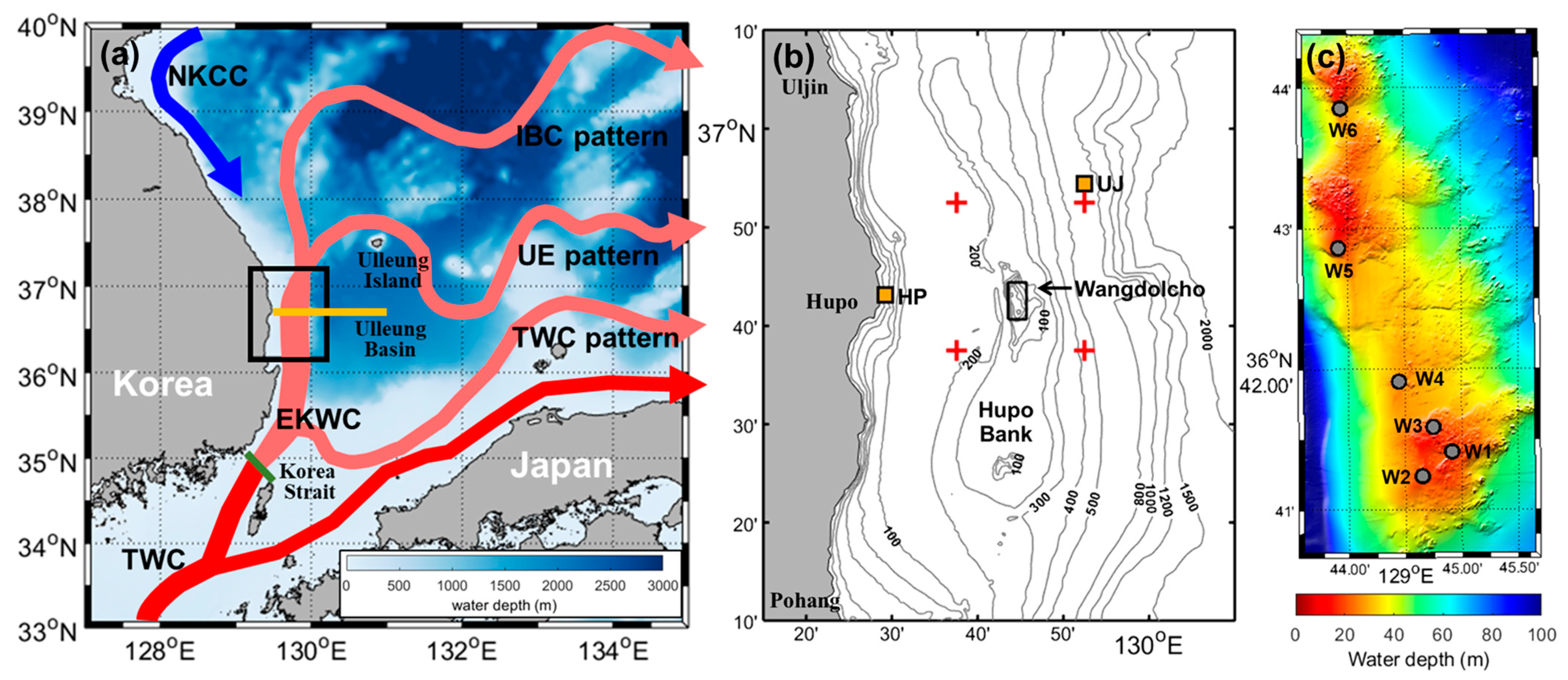
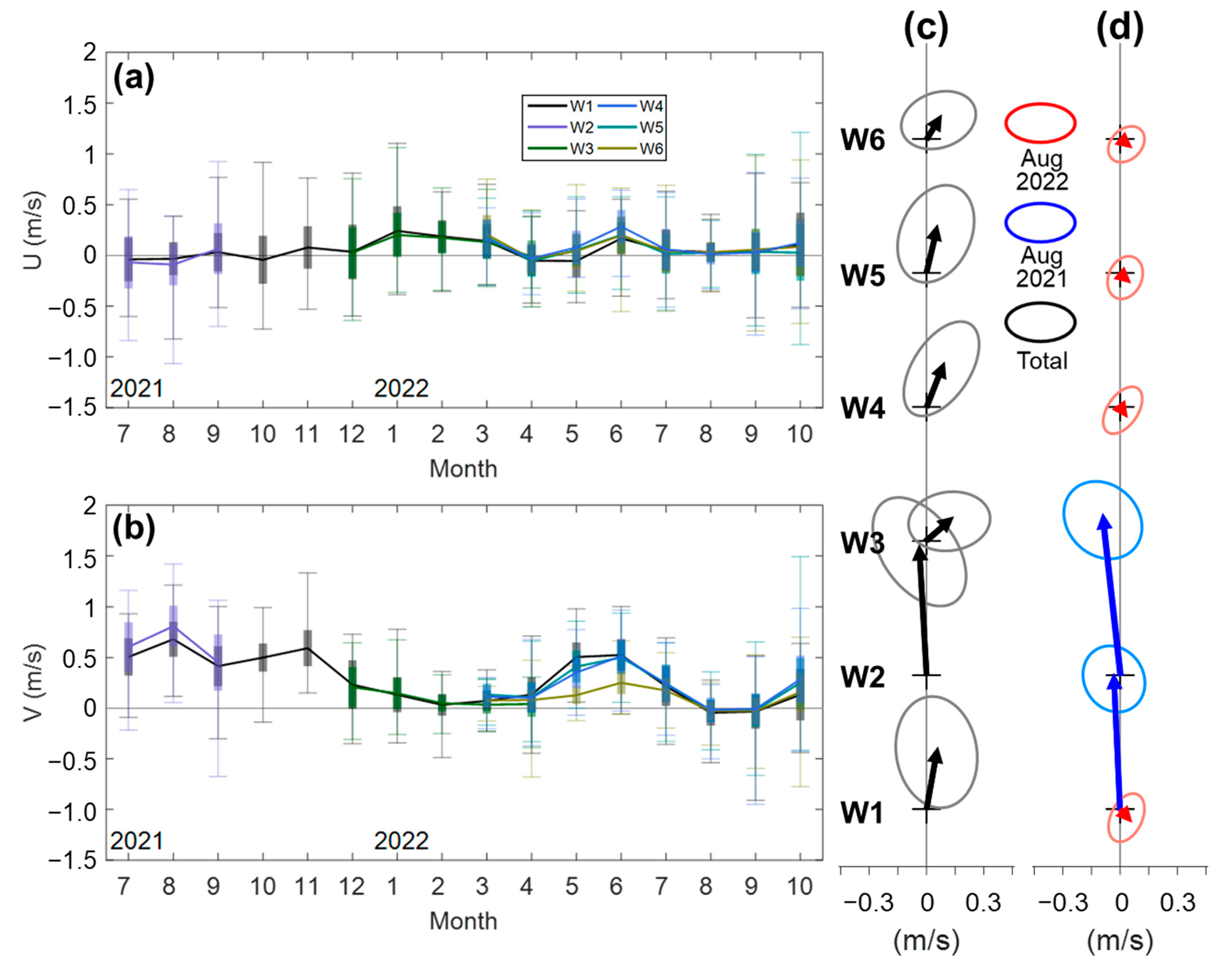
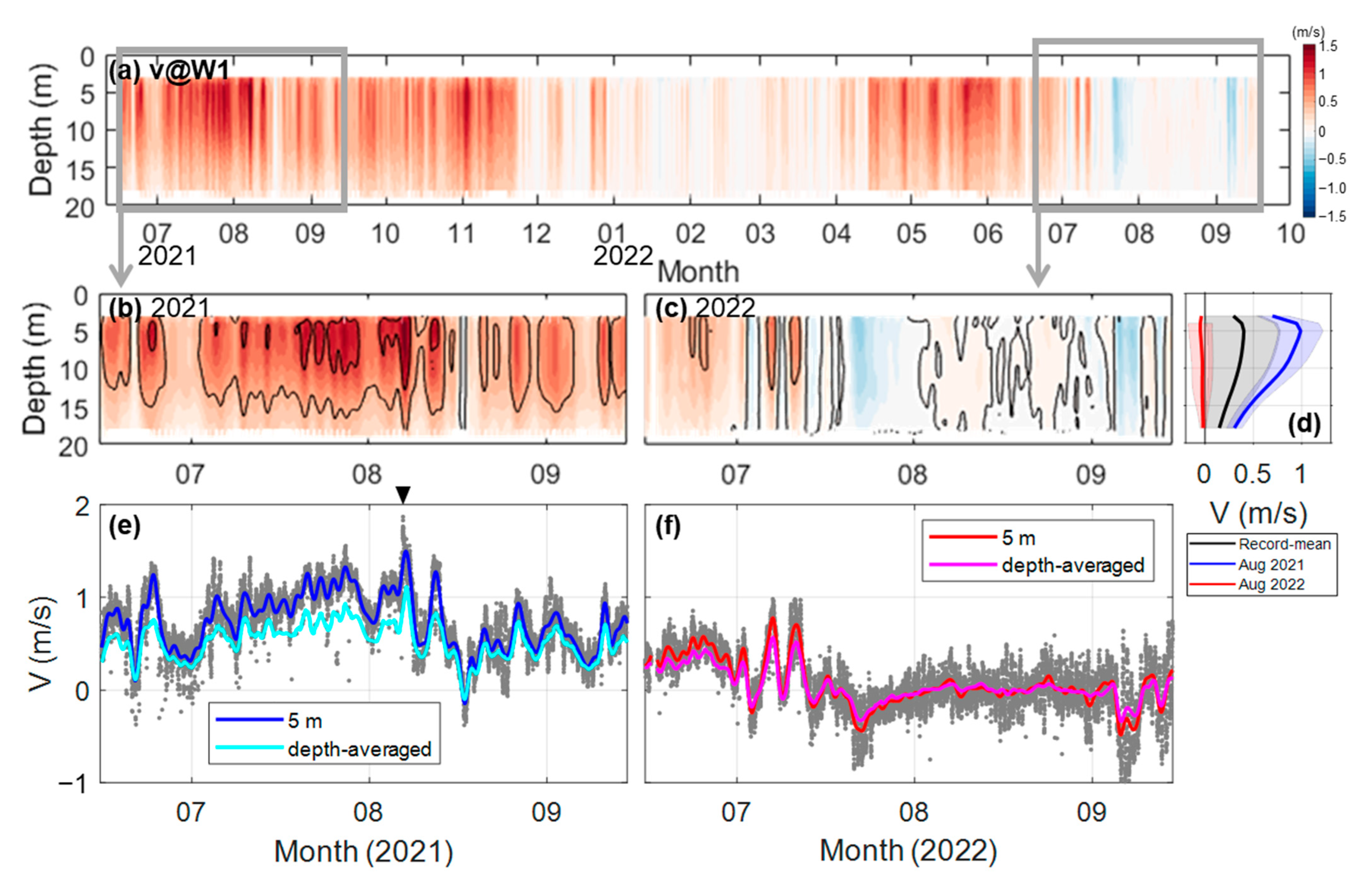
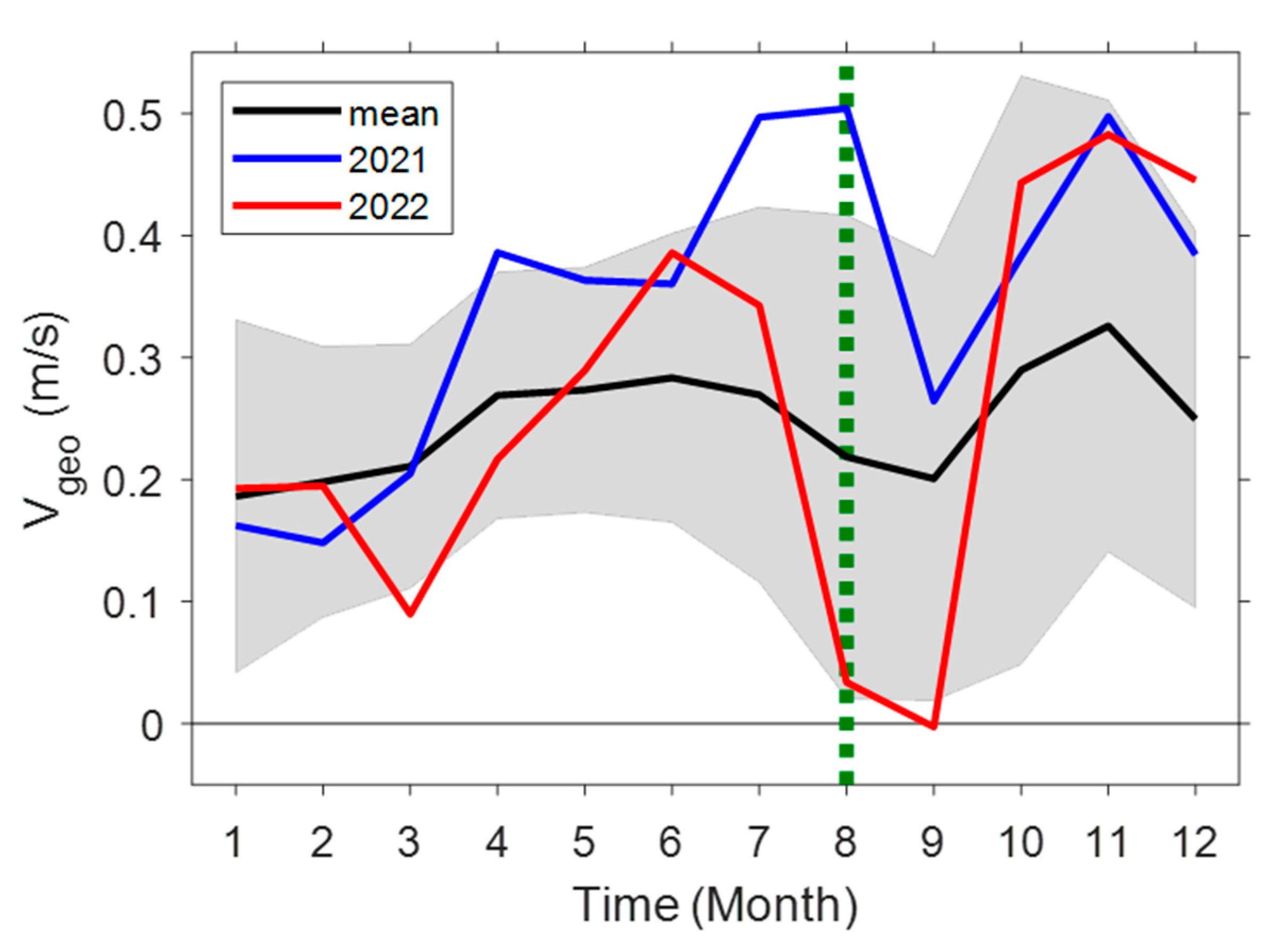

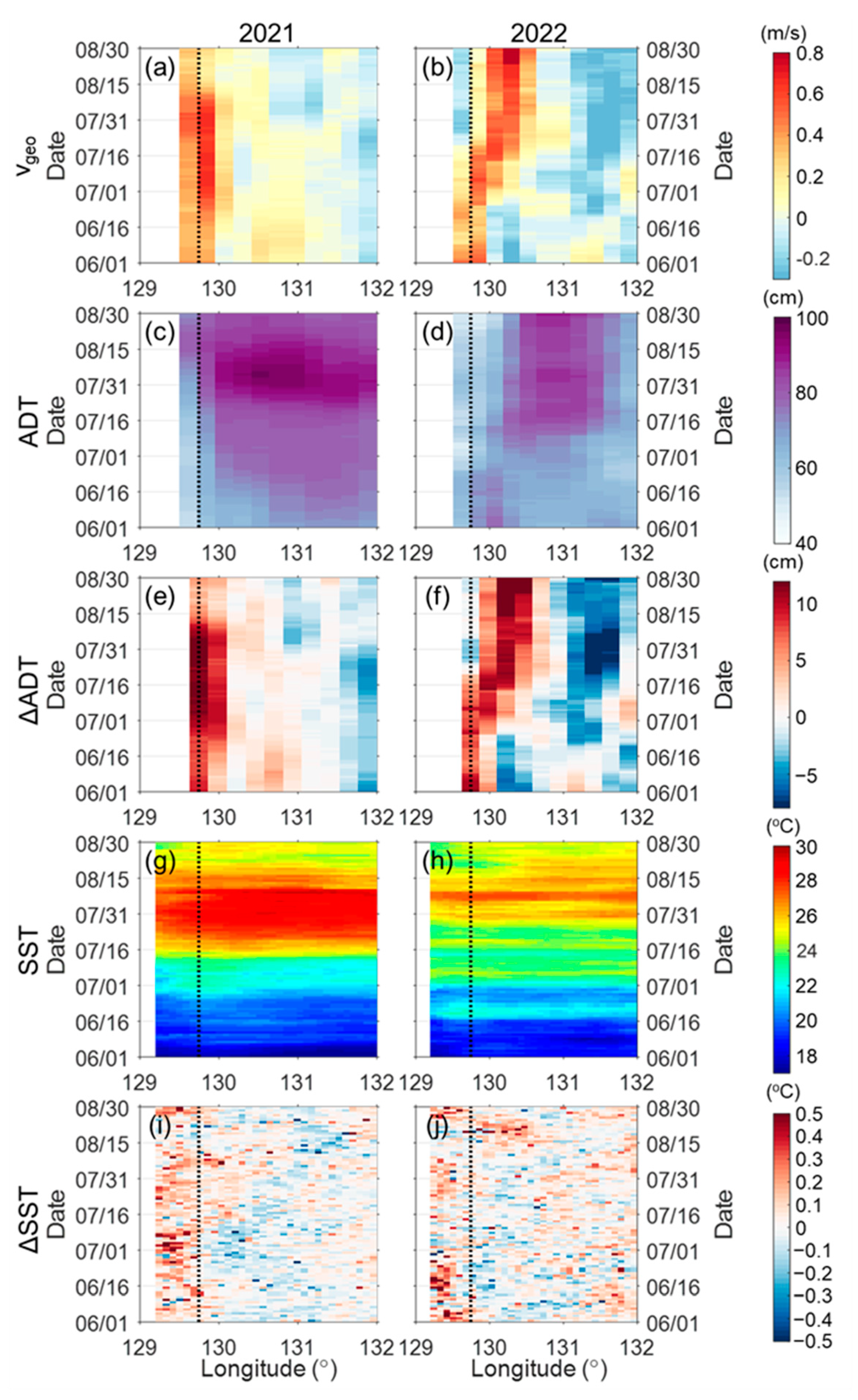
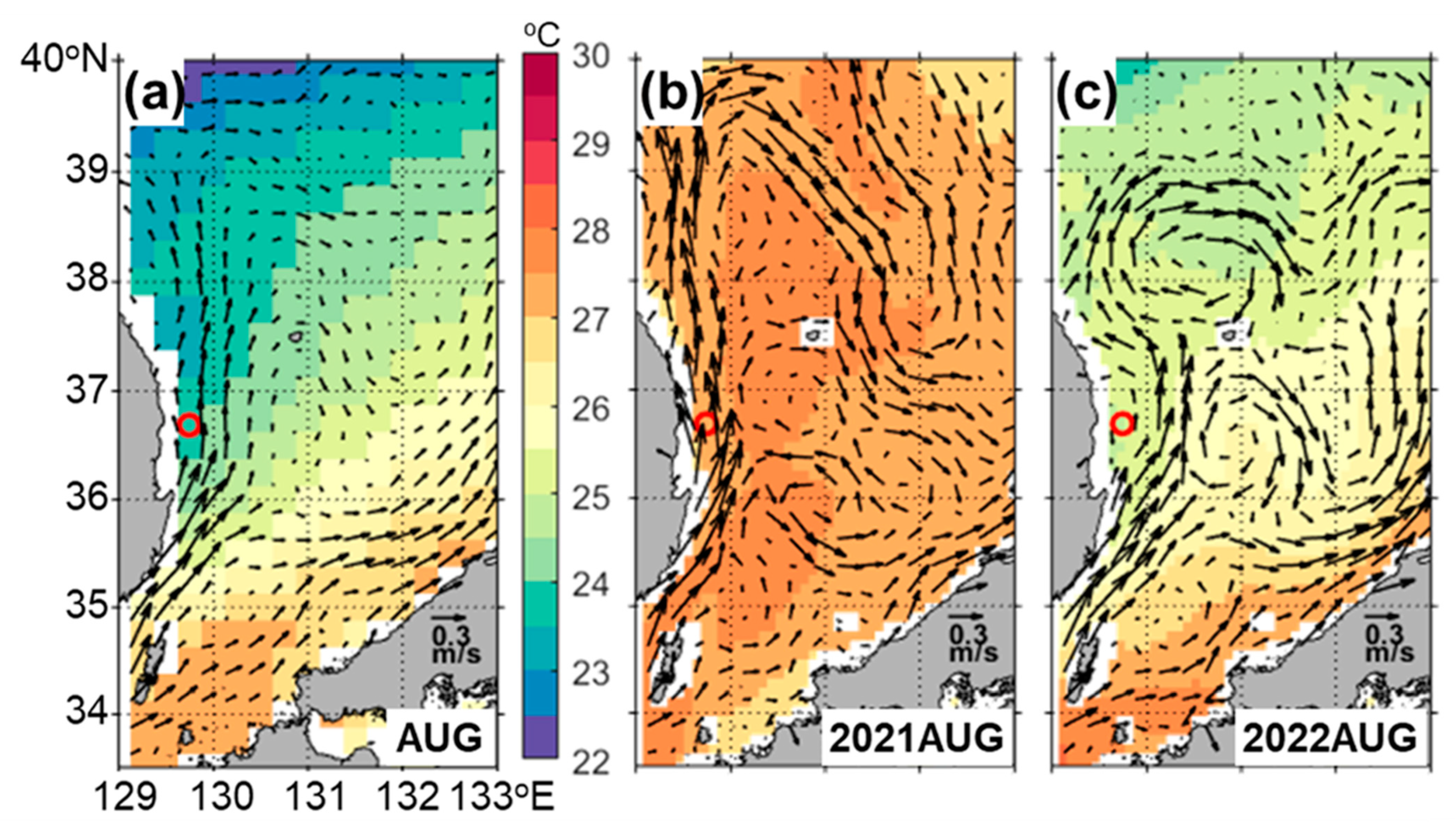
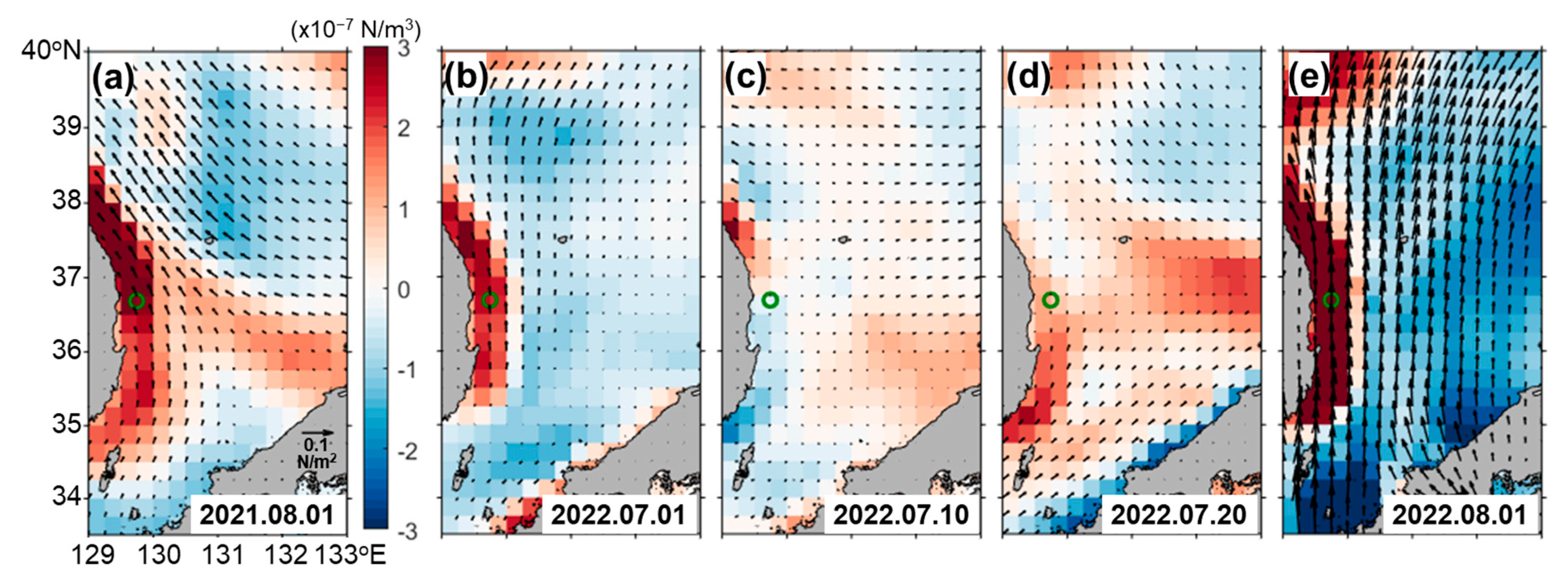

| Mooring | Location | Depth | Start Time | End time | Bin Size | Sampling Interval | Frequency |
|---|---|---|---|---|---|---|---|
| W1 | 36°41′24.70″ N 129°44′54.78″ E | 20 m | 15 June 2021 | 19 September 2022 | 1 m | 10 min | 600 kHz |
| W2 | 36°41′14.3″ N 129°44′39.0″ E | 17 m | 24 June2021 | 6 September 2021 | 1 m | 10 min | 1 MHz |
| W3 | 36°41′35.23″ N 129°44′44.88″ E | 20 m | 16 November 2021 | 29 March 2022 | 1 m | 10 min | 600 kHz |
| W4 | 36°41′54.65″ N 129°44′26.78″ E | 25 m | 9 March 2022 | 12 October 2022 | 1 m | 10 min | 500 kHz |
| W5 | 36°42′51.72″ N 129°43′54.87″ E | 22 m | 9 March 2022 | 12 October 2022 | 1 m | 10 min | 500 kHz |
| W6 | 36°43′51.28″ N 129°43′56.38″ E | 25 m | 9 March 2022 | 10 October2022 | 1 m | 10 min | 500 kHz |
| W1 Moorings | 2021 | 2022 | ||||||||||||||||
|---|---|---|---|---|---|---|---|---|---|---|---|---|---|---|---|---|---|---|
| Jun. | Jul. | Aug. | Sep. | Oct. | Nov. | Dec. | Jan. | Feb. | Mar. | Apr. | May | Jun. | Jul. | Aug. | Sep. | |||
| Mean () | U | −0.07 | −0.04 | −0.03 | 0.02 | −0.04 | 0.09 | 0.03 | 0.25 | 0.19 | 0.14 | −0.05 | −0.06 | 0.18 | 0.05 | 0.03 | 0.04 | |
| V | 0.38 | 0.60 | 0.81 | 0.45 | 0.50 | 0.59 | 0.22 | 0.13 | 0.04 | 0.08 | 0.15 | 0.50 | 0.52 | 0.21 | −0.05 | −0.03 | ||
| STD () | U | 0.11 | 0.21 | 0.17 | 0.19 | 0.23 | 0.21 | 0.30 | 0.23 | 0.16 | 0.17 | 0.15 | 0.16 | 0.14 | 0.21 | 0.09 | 0.19 | |
| V | 0.09 | 0.18 | 0.17 | 0.20 | 0.14 | 0.17 | 0.23 | 0.17 | 0.11 | 0.10 | 0.19 | 0.14 | 0.16 | 0.20 | 0.12 | 0.18 | ||
| Max. () | U | 0.09 | 0.51 | 0.40 | 0.74 | 0.88 | 0.70 | 0.78 | 1.03 | 0.59 | 0.63 | 0.36 | 0.39 | 0.54 | 0.61 | 0.28 | 0.78 | |
| V | 0.53 | 0.89 | 1.20 | 0.92 | 0.98 | 1.26 | 0.71 | 0.70 | 0.32 | 0.35 | 0.68 | 0.92 | 0.98 | 0.66 | 0.26 | 0.50 | ||
| Min. () | U | −0.22 | −0.58 | −0.81 | −0.50 | −0.68 | −0.51 | −0.55 | −0.24 | −0.31 | −0.26 | −0.45 | −0.43 | −0.39 | −0.41 | −0.30 | −0.59 | |
| V | 0.22 | 0.01 | 0.17 | −0.25 | −0.13 | 0.17 | −0.31 | −0.31 | −0.23 | −0.21 | −0.41 | 0.11 | 0.13 | −0.31 | −0.51 | −0.76 | ||
| Vector mean | Speed () | 0.40 | 0.66 | 0.83 | 0.46 | 0.56 | 0.63 | 0.38 | 0.34 | 0.24 | 0.22 | 0.25 | 0.53 | 0.57 | 0.32 | 0.14 | 0.21 | |
| Dir. () | 97 | 92 | 91 | 85 | 93 | 85 | 56 | 24 | 5 | 25 | 67 | 94 | 70 | 48 | −26 | −10 | ||
| Max. () | 0.57 | 0.93 | 1.22 | 0.94 | 1.08 | 1.28 | 0.81 | 1.09 | 0.61 | 0.63 | 0.68 | 0.92 | 0.98 | 0.73 | 0.53 | 0.83 | ||
| MKE () | 0.08 | 0.13 | 0.23 | 0.09 | 0.13 | 0.18 | 0.03 | 0.04 | 0.02 | 0.01 | 0.01 | 0.13 | 0.15 | 0.02 | 0.01 | 0.01 | ||
| EKE () | 0.01 | 0.04 | 0.03 | 0.04 | 0.04 | 0.04 | 0.06 | 0.04 | 0.02 | 0.02 | 0.03 | 0.02 | 0.02 | 0.04 | 0.01 | 0.03 | ||
| EKE/MKE | 0.12 | 0.29 | 0.13 | 0.41 | 0.29 | 0.20 | 2.58 | 1.03 | 1.05 | 1.54 | 2.23 | 0.19 | 0.15 | 1.82 | 6.75 | 31.41 | ||
| Principal axis () | 140 | 157 | 126 | 131 | 3 | 22 | 25 | 22 | 5 | 14 | 104 | 143 | 101 | 41 | 65 | 16 | ||
| Direction stability | 0.98 | 0.93 | 0.97 | 0.90 | 0.91 | 0.95 | 0.59 | 0.85 | 0.79 | 0.73 | 0.65 | 0.95 | 0.97 | 0.66 | 0.43 | 0.22 | ||
Disclaimer/Publisher’s Note: The statements, opinions and data contained in all publications are solely those of the individual author(s) and contributor(s) and not of MDPI and/or the editor(s). MDPI and/or the editor(s) disclaim responsibility for any injury to people or property resulting from any ideas, methods, instructions or products referred to in the content. |
© 2024 by the authors. Licensee MDPI, Basel, Switzerland. This article is an open access article distributed under the terms and conditions of the Creative Commons Attribution (CC BY) license (https://creativecommons.org/licenses/by/4.0/).
Share and Cite
Lee, S.-W.; Pak, G.; Park, J.-H.; Lee, S.-C.; Jeong, J.-Y.; Noh, S. Comparison of Summer Coastal Currents off the East Coast of Korea in 2021 and 2022. J. Mar. Sci. Eng. 2024, 12, 1512. https://doi.org/10.3390/jmse12091512
Lee S-W, Pak G, Park J-H, Lee S-C, Jeong J-Y, Noh S. Comparison of Summer Coastal Currents off the East Coast of Korea in 2021 and 2022. Journal of Marine Science and Engineering. 2024; 12(9):1512. https://doi.org/10.3390/jmse12091512
Chicago/Turabian StyleLee, Seung-Woo, Gyundo Pak, Jae-Hyoung Park, Su-Chan Lee, Jin-Yong Jeong, and Suyun Noh. 2024. "Comparison of Summer Coastal Currents off the East Coast of Korea in 2021 and 2022" Journal of Marine Science and Engineering 12, no. 9: 1512. https://doi.org/10.3390/jmse12091512





